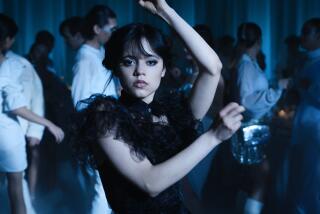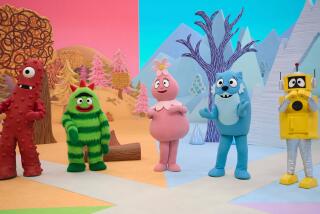Critic’s notebook: In praise of children’s TV
I am far past childhood, but I still like watching TV made for kids. Some of this is out of professional interest, obviously, but in the long span of my life and working life, the professional interest is comparatively recent, and I have never really stopped paying attention to children’s television, never felt above it, or beyond it. Indeed, the more I’ve watched it, the more I’ve grown to think of it as the medium’s better self — by its very nature more colorful, wilder, weirder, purer. A few dozen words will serve to accurately describe pretty much any prime-time comedy or drama, but the only way to understand something as unlikely as “Teletubbies” is to watch it.
This has all been quite on purpose and without the company of children — parents will see a lot of kids’ shows incidentally, of course. It’s not in search of lost innocence that I watch them, like a psychedelically regressed hippie burrowing back into “Alice in Wonderland” or “The Wind in the Willows.”
Yet there’s a liberating freedom from convention and conventionality in the best of it, a formal adventurousness that adult-targeted programming approaches only at its margins. (“Food Party,” or “The Late Late Show With Craig Ferguson,” where puppets live.) For all its variety, grown-up TV gives short shrift to beauty, poetry, delight, joy, silliness, magic, music and color — the cornerstones of children’s TV, when it is not behaving merely like some pint-sized version of the CBS Monday-night sitcom block. These are qualities that seem more useful to me than the disquiet and despair that underlie much of the television designed for people “my age.”
In my teens, I tuned into “Sesame Street” and “The Electric Company,” even though I could already count and read and knew my triangles from my rectangles, for the animation and attitude (urban, funky, sharp), and to “Zoom,” because it loved life and the music was good. Saturday mornings I had a date with the free-associative “Make a Wish,” a quick-cut ramble through the English language. Later, when I was incontrovertibly grown, I made time for the companionable anarchy of “Pee Wee’s Playhouse” and the sly wit of Shelley Duvall’s “Faerie Tale Theatre,” which cast known quantities in smartly scripted and beautifully designed recastings of the classics: Matthew Broderick and Jennifer Beals in “Cinderella,” Tom Conti and Liza Minnelli in “The Princess and the Pea,” Carl Reiner and Paul Reubens in a Pee-Wee-esque “Pinocchio.”
Later still, there were “The Powerpuff Girls” and “Dexter’s Laboratory” and “Ned’s Declassified School Survival Guide” (from Scott Fellows, also of the similar and current “Big Time Rush”); with its abrupt shifts of tone and attention and its Looney Tunes soundtrack, it seems to me nothing so much as the child that is the father of “30 Rock.” There was the Europop callisthenic melodrama “Lazytown.” Lately there are “Adventure Time With Finn & Jake,” “The Marvelous Misadventures of Flapjack,” “Fanboy & Chum Chum” and “Planet Sheen,” legible to the smallest small fry and cleverer than the job would seem to require. And there is certainly the phenomenal “Yo Gabba Gabba!,” with its post-punk, electrofunky minimalism, its hypnotically repetitive music, delivered by bona fide indie stars, its vinyl-smooth happy monsters and color-coded seasonal backdrops set within a white infinite universe.
Animators have come into their own: With a regard for the history of their art and a forward-driving sense of (what I imagine to be friendly) competition, each reflects not a network house style but an individual nexus of influence and vision. Each to its own world “The Wonder Pets” (photo-collaged baby animals sing opera), “Rolie Polie Olie” (Art Deco robots); and “Invader Zim” (rough, underground, dark). All the elements in a cartoon are integrated, the colors and shapes and sound effects as much a part of the meaning as what any character says or does.
My favorite of all kids’ shows, and possibly of all shows ever, is “The Adventures of Pete & Pete,” which ran in the early ‘90s in that golden age of Nickelodeon that also gave the world “Clarissa Explains It All,” where Melissa Joan Hart first made her mark. The story of two brothers named Pete, it takes place in a leafy suburb at the corner of innocence and experience. It’s full of surreal little touches — little Pete has a dancing-girl tattoo on his arm, Mom a plate in her head that picks up radio — but its main aim is to make you feel the beauties and dangers of the real world in a moment of becoming, locating the mythic mystery in everything from soft-serve ice cream to the dot on the “i” in a marching band formation. It makes room for darkness too. This is a place where a little kid attempts to stay up 11 days past his bedtime, a game of dodgeball morphs into the American Revolution.
It is a beautiful thing that, unlike actual youth, need not be wasted on the young.
More to Read
The complete guide to home viewing
Get Screen Gab for everything about the TV shows and streaming movies everyone’s talking about.
You may occasionally receive promotional content from the Los Angeles Times.







